
 |
Home | Nanga Parbat Main | Contact |
Updated: April 2012. Click on an image to see the FULL size with a caption.
The following reference information is included:
My rating scale:
 Excellent ;
Excellent ;
 Very Good ;
Very Good ;
 Good ;
Good ;
 Fair ;
Fair ;
 Poor.
Poor.
Please see K2 Trekking Guidebooks.
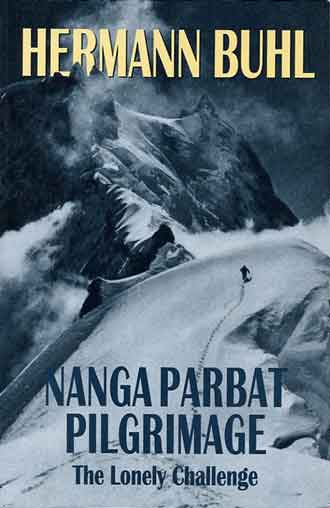

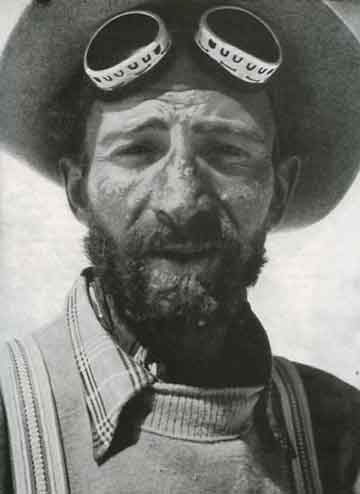

by Hermann Buhl. Originally published in 1954. One of Michael Chessler's Top 100 Mountaineering Books. Buhl begins his autobiography with his climbs in the North Tirol (including Schusselkarspitze and Laliderer), and the Dolomites (including Western Zinne North and Marmolata). He then moves to the Western Alps (including the Grandes Jorasses, Mont Blanc and Eiger) and ends with one of the single greatest achievements in mountaineering history, Buhl's successful 1953 solo climb of Nanga Parbat. There are 16 pages of b/w photos and 3 maps, with 4 pages and 1 map for Nanga Parbat. The front cover is Uli Wieland climbing towards the Moor's Head on the Nanga Parbat East Ridge, with the Silver Saddle beyond.
On Nanga Parbat, Buhl kept in the front, always climbing and pushing out the high camps, suffering coughing attacks, avalanches, storms and a lack of porters. He couldn't resist climbing peaks along the way, including Rahkiot Peak (7077m). When they were nearing their summit push, Base Camp called and told them repeatedly to abandon the climb and come down. Buhl, Walter Frauenbergar, Otto Kempter and camera man Hans Ertl disobeyed the order and decided to go for the top. On July 2, Ertl and Fruenberger returned to Camp IV, while Buhl and Kempter established Camp V. "We were still 4,000 feet below the top vertically, and nearly four miles from it as the crow flies. That was a tremendous distance; nothing like it had ever been done at such an altitude in the Himalaya." Kempter left camp an hour after Buhl, but realised he would never catch up, and turned back and reached Camp V safely.
Buhl struggled on alone. "I moved forward in a kind of self-induced hypnosis." Buhl reached the summit of Nanga Parbat on July 3rd at 7pm. "I felt as if I were floating high above everything, out of all relationship with the Earth, severed from the world and all humanity. ... The sun went down behind a mountain range and in the instant the cold was penetrating." He had to bivouac on a narrow ledge all night without any sleeping bag or warm clothes. It took him all of the next day to stagger back to their high tent.
Buhl took enormous risks and succeeded where others had failed. I really like the writing style, direct and passionate. Buhl can pack quite an intense and detailed story into such a few pages. The photos are very good.
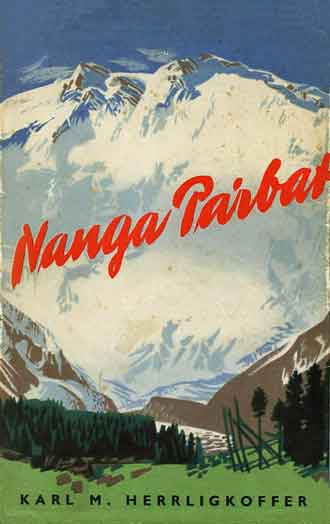
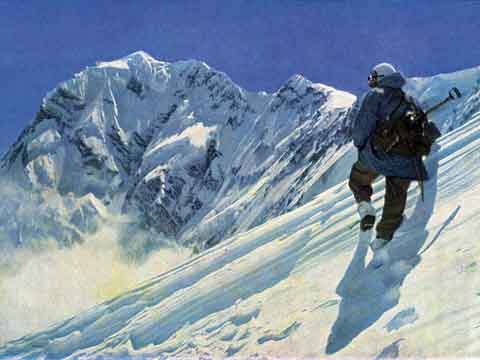
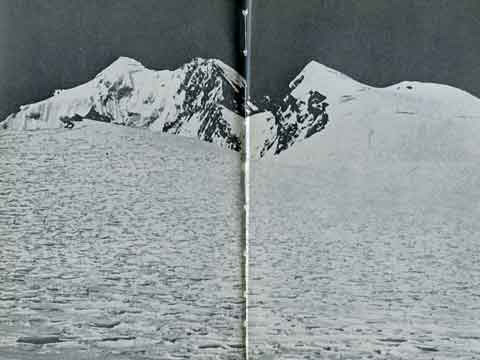
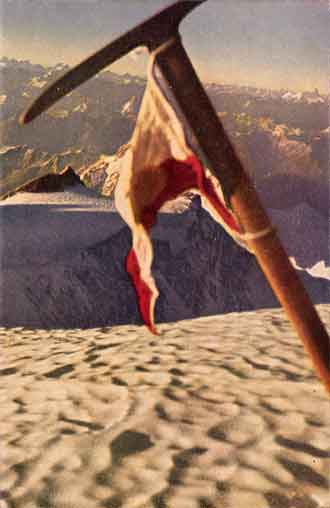


First published in English in 1954. The first section of the book, called The Tragedies, was written by Eleanor Brockett and Anton Ehrenzweig, and details the historical attempts from 1895 to 1950. The second section of the book, called Triumph, was written by Karl Herrligkoffer and is his account of the first ascent of Nanga Parbat in 1953. There are 9 pages of colour photos, 45 pages of b/w photos, 4 route maps, and 3 maps.
The tragedies starts with the British Expedition of 1895 with Albert F. Mummery reaching almost 7000m on the Diamir Face, but Mummery and two Gurkha companions later died reconnoitering the Rakhiot Face. The German-American Expedition of 1932, led by Willy Merkl, was turned back by excessive snowfall.
The tragic German Expedition of 1934 was led by Willy Merkl. Alfred Drexel died at C2, now believed to be due to pulmonary edema. Peter Aschenbrenner and Erwin Schneider got to only 900m below the summit, but then: "The elements were unleashed and the storm raged on. ... In the days which followed, however, a drama of heart-rending tragedy unfolded itself before the helpless onlookers below. Wieland had laid down in the snow there and died from exhaustion." On July 8 one Sherpa died; on July 10 three porters collapsed and died; on the night of July 12 Wilo Welzenbach died in Camp 7. "But no rescue was possible. The next morning, 15th July, the wind still carried cries for help from the Arête to the helpless onlookers below, but nothing could be seen. The blizzard raged on without respite. The cries from above ceased. Willy Merkl and his faithful Gay-Lay were silent for ever."
The German Expedition of 1937 ended in tragedy when nine Sherpas and seven Germans were hit by an avalanche at Camp 4 when an ice cornice broke away and caused an enormous avalanche, burying the men as they slept. The only German survivor Uli Loft said, “The Silver Saddle gleamed in the sun high above me, serene and withdrawn. The team was no more.” The German Expedition of 1938, led by Paul Bauer, floundered due to lack of Sherpas and bad weather. The Reconnaissance of 1939 explored the Diamir Face with the aim of finding an easier route. This expedition was led by Peter Aufschnaiter and featured Heinrich Harrer, who were arrested at Karachi in September 1939 and went on to Seven years In Tibet fame. In the Winter Escapade of 1950, two young Englishmen died in December 1950 low on the mountain. "The death toll of Nanga Parbat now stood at 14 climbers and 17 porters."
Karl Herrligkoffer was the step-brother of Willy Merkl and at the age of 20 in 1937 vowed to "organize a new German Himalayan expedition, whose task it would be to set the seal of victory upon the heroic efforts of our dead comrades, to fulfill, in fact, a sacred trust." Herrligkoffer successfully organized the 1953 expedition, and briefly describes traveling to base camp, the troubles they had with the lack of good porters, and pushing the route out to camp 5. Herrligkoffer uses excerpts from the diaries of Peter Aschenbrener, Otto Kempter, Walter Frauenberger, and Hermann Buhl's 9-page story of his summit to keep the story moving past base camp.
"Why had Kempter returned alone? Where was Buhl? He had no tent with him, no sleeping bag, no food. He knew, as all of us knew, that above 26,000 feet one could not survive a night in the open. ... Again and again our thoughts went up to the summit like a prayer; somewhere up there in this soft, shimmering moon-flooded night our comrade Hermann Buhl, alone but on behalf of us all, was engaged in the final combat." Hermann Buhl: "I now left the ski-sticks behind and – I could do it no other way – scrambled up on all fours. Suddenly I realized that I could go no higher … I was on the summit." Hermann Buhl reached the summit of Nanga Parbat on July 3, 1953 at 7pm.
Walter Frauenberger: "A tiny black dot detached itself from the rocks on the Silver Saddle, passed below the rim on the sky-line and was now moving on downwards ... Hermann Buhl had come from the summit … victory was ours! Once more I felt my heart beat furiously and my eyes filled with tears. I turned and read again the names inscribed on the tablet which we had placed on the Moor’s Head: Willy Merkl, Wilo Welzenbach and Uli Wieland. I communed with the dead. After an interval of 20 years their sacred trust had at last been fulfilled."
"As Buhl staggered and swayed the last few feet of the ridge he fell into the arms of Hans Ertl who had gone up to meet him. He looked aged by 20 years. His face, desiccated and deeply lined, bore the imprint of intolerable suffering. From his lips fell the words: 'Yesterday was the finest day of my life.' Although torn with grief at the sight of his friend’s agony, Ertl filmed Buhl’s last steps to the tent and so put on permanent record the final moments of this unique adventure."
The Tragedies section of this book is short, concise and riveting. It's a perfect overview of the attempts to climb Nanga Parbat. Herrligkoffer's story of the first ascent is tight, well written and balanced, not biased at all, and uses climbers' diaries to keep the story action-packed as they reach the summit. The photos are excellent.
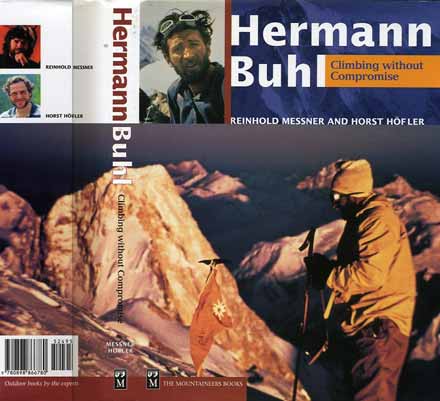
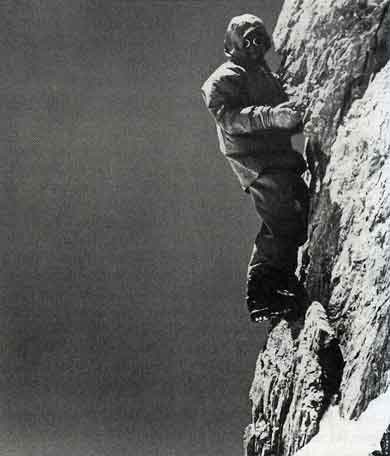
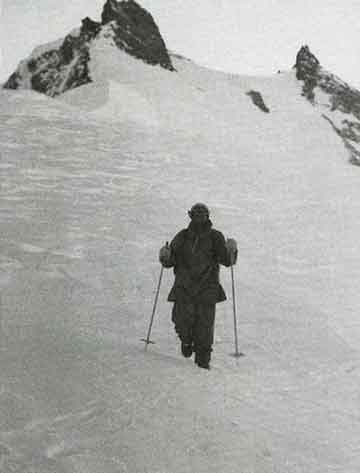
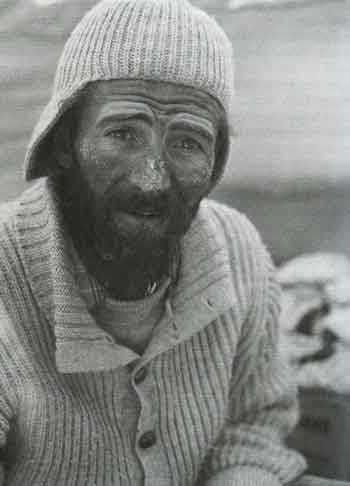

by Reinhold Messner and Horst Hofler. First published in English in 2000. This biography includes material from Buhl's previously unavailable diaries, as well as interviews with Buhl's family and climbing partners. There are 43 colour and 83 b/w photos, with 4 colour and 14 b/w photos of Nanga Parbat. The front cover photo of Buhl on the summit of Broad Peak is by Kurt Diemberger.
This book follows the outline of Nanga Parbat Pilgrimage: The Lonely Challenge highlighting his climbs in the North Tirol (including Schusselkarspitze and Laliderer), the Dolomites (including Western Zinne North and Marmolata), the Western Alps (including the Grandes Jorasses, Mont Blanc and Eiger), and Buhl's successful 1953 solo climb of Nanga Parbat. It then adds his climb of the Dru west face in 1956 and Broad Peak in 1957.
The Nanga Parbat attempt is documented with excerpts from Buhl's diaries. Buhl's diary ends in the afternoon of the summit day, so Messner picks another Buhl article to complete the summit and descent. Messner also looks at the conflict between Buhl and Herrligkoffer after the expedition.
This is a good companion book to Buhl's Nanga Parbat Lonely Challenge. I really enjoyed the many extra photos. The writing itself is straightforward.
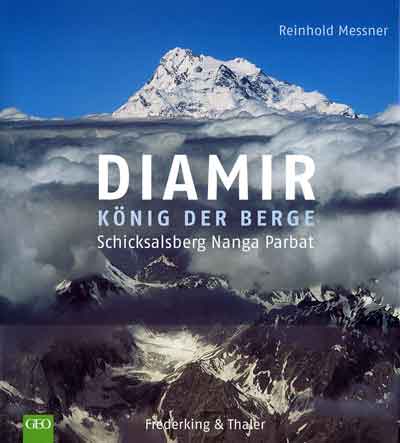
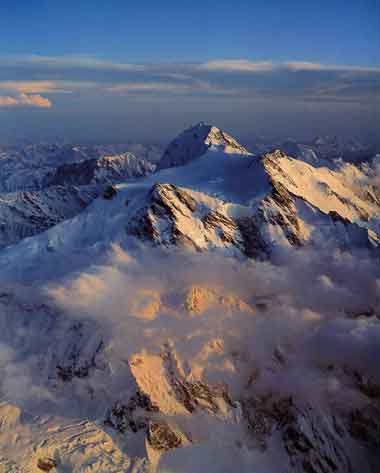
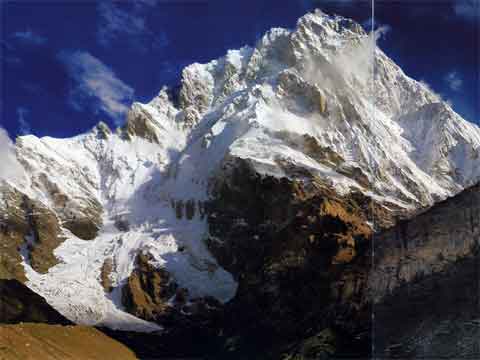
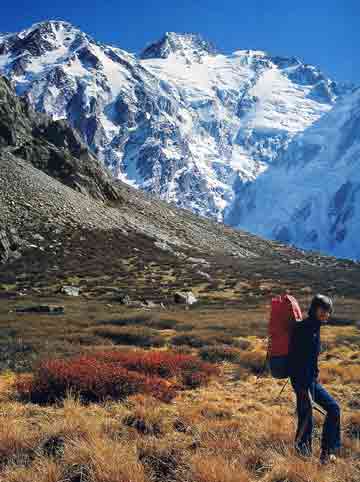
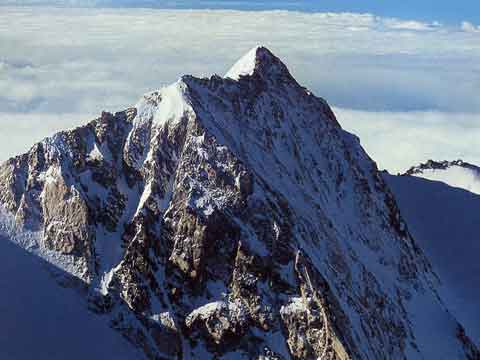

by Reinhold Messner. Published in 2008. In German. A beautiful, large-format, book on the history of Nanga Parbat. Using archival material, historical photos, and spectacular aerial photos, Messner tells the history of climbing on Nanga Parbat from 1895 to 2005. The book begins with attempts from Mummery (1895), the pre-war German attempts (1932, 34. 37, 38), Hermann Buhl’s first ascent (1953), the (Toni) Kinshofer Diamir Face ascent (1962), the ascent of the Rupal Face by Reinhold and Gunther Messner (1970), the Schell route on the south/south-west ridge at the edge of the Rupal Face (1976), Reinhold Messner's solo ascent (1978), the Polish/Mexican Rupal Face Southwest Pillar (1985), the Japanese North Side Route (1995), finding Gunther Messner's remains (2005), and Steve House and Vince Anderson on the Central Pillar of the Rupal Face (2005). There are 133 color photos, 67 bw photos, and a superb map.
This is the definitive book on Nanga Parbat, providing full history up to 2005. Messner's photos of Nanga Parbat from the air amazing.
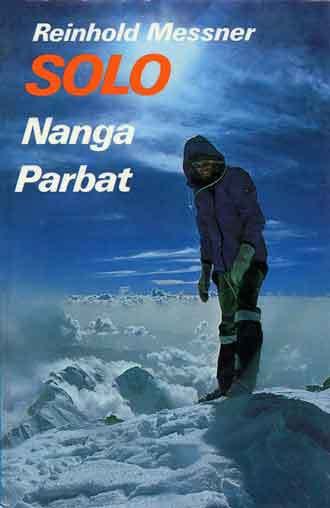
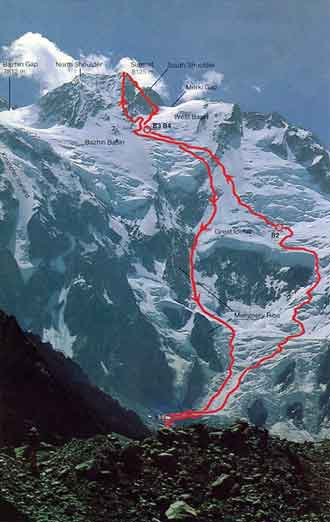
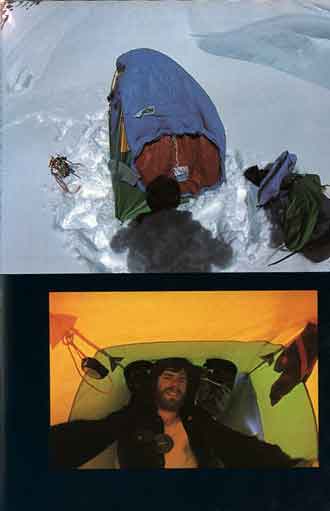
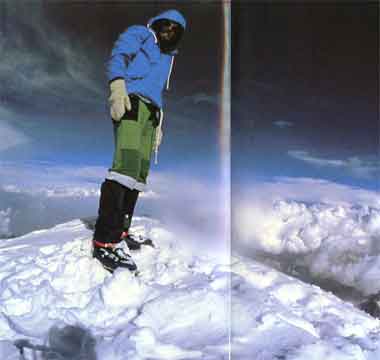
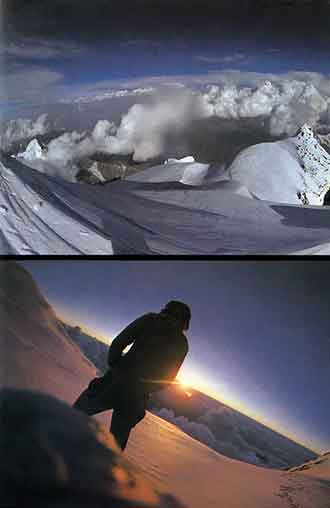

by Reinhold Messner. First published in English in 1980. One of Michael Chessler's Top 100 Mountaineering Books. Just a few months after climbing Everest without oxygen, Reinhold Messner is back with a bolder challenge: to climb Nanga Parbat solo. The cover is Reinhold Messner on the Nanga Parbat summit on August 9, 1970. The appendix contains a history of Nanga Parbat attempts and successful ascents. There are 51 pages of colour photos, 6 pages of b/w photos, 51 b/w photos in-line with text, 30 small b/w photos on the Nanga Parbat summit, 5 maps, and 6 mountain drawings.
Messner travels to the Diamir Base Camp and waits and waits for the right weather window. The only people with him are Ursula Grether who was in charge of the medical side of the expedition, and the liaison officer Terry. "I know that this climb is very dangerous and will push me to the limit of my capabilities." Messner leaves Base Camp on August 6 at noon and bivouacs at the bottom of the Diamir Face. The next day he climbs 1600m in 6 hours and bivouacs at 6400m. "In all this peace I have been able to attain a new self-awareness … loneliness is no longer a catastrophe!" An earthquake hits the morning of August 8. "Beneath me a wide avalanche swept like a tidal wave down the mountain. It was made up of ice that I had climbed yesterday. It swept right over the spot where I was bivouacking yesterday at this time." He climbs to 7400m for his third bivouac, and leaves a little late on August 9 for the summit. "I balance along narrow ledges, no wider than the palm of my hand, and wallow through snow-choked gulleys."
Messner finally reached the Nanga Parbat summit on August 9, 1978. "I wander around in a circle, repeatedly looking at the view, as if I can hardly believe I’m really here. ... The summit seems so peaceful and the descent so unnecessary. It is as if I had no further meaning at all; as if I had crawled out of a sea of loneliness into the safety of the cosmos. ... And the silence urges me to treat the summit very gently. ‘I and the summit are one, yet we are different ...’ He descends and bivouacs again at 7400m. There is a snowstorm on August 10, so he has to stay at his bivouac. The next day the weather improves and he decides that, "I have to reach base camp in one single mammoth stage."
Messner's writing is interesting and poetic, letting us know his raw feelings and inner-most thoughts. The photos are excellent.

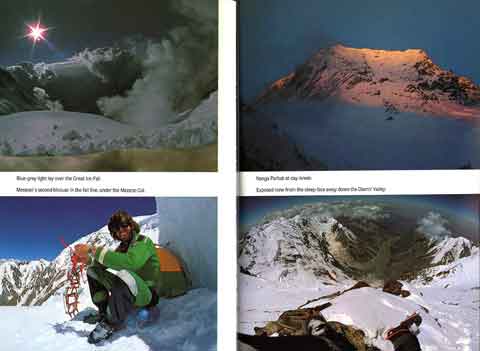


by Reinhold Messner. Published in English in 1992. The book briefly describes Messner's ascents of Manaslu in 1972, Gasherbrum I (Hidden Peak) in 1975, Everest without oxygen in 1978 and Everest solo in 1980, Nanga Parbat solo in 1978, K2 in 1979, and a traverse of Gasherbrum I and II in 1984. There are 56 pages of colour photos, 20 pages of b/w photos, 26 b/w photos, and six paintings by French artist Jean-George Inca.
The chapter on Nanga Parbat is 46 pages long with 12 pages of colour photos, 5 b/w photos in-line with text, 12 small b/w photos on the Nanga Parbat Summit, a route map, and a 2-page painting by Inca. Just a few months after climbing Everest without oxygen, Reinhold Messner is back with a bolder challenge: to climb Nanga Parbat solo.
"The air above the summit ridge was still clear, the sky deep blue to black. Did the world come to an end up there?" Messner finally reaches the Nanga Parbat summit on August 9, 1978. "I circled around, looked about me once more as if I did not believe that I was actually on top. ... As I sat there I too became cloud and mist. The infinite calm released contentment in me."
If you want a Best Of Messner book, this is a great choice. The photos are excellent. The translation is not as good as the original in the Solo: Nanga Parbat book; it's less poetic and a bit awkward. Messner's writing is interesting and poetic, letting us know his feelings and inner-most thoughts.
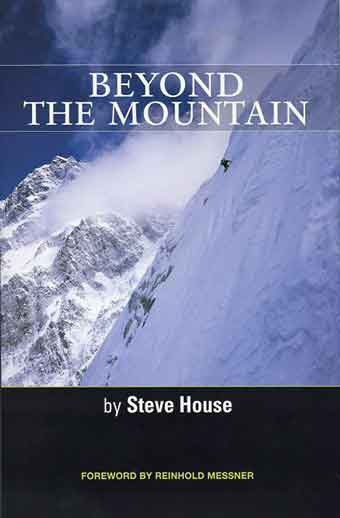
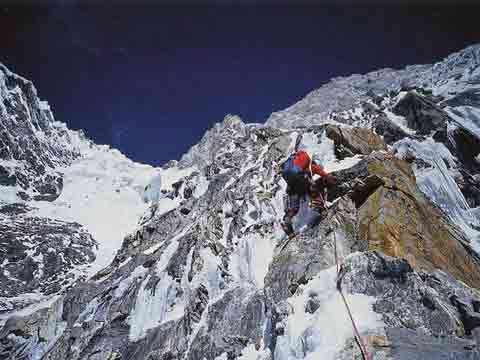
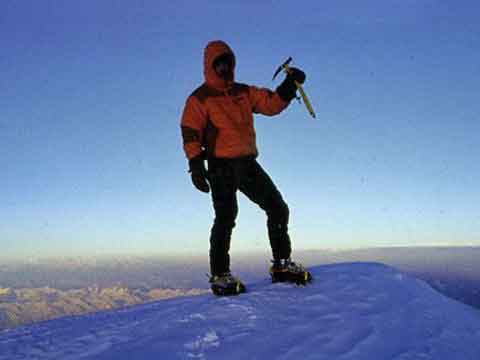

by Steve House. Published 2009. Winner of the 2009 Boardman Tasker Prize for Mountain Literature. Nanga Parbat book ends Steve House’s climbing career with his early attempt on Nanga Parbat in 1990, and his successful ascent in 2005 with Vince Anderson of a new route on the extremely difficult Nanga Parbat Rupal Face Central Pillar, done in five days plus two down, in alpine style, making them winners of the famous Piolet d`Or that year.
In between, Steve chronicles his climbs, including the unclimbed Denali Father and Son Wall in 1995, a new route solo on Denali Washburn Wall in 1996, the second ascent of the Barely Legal ice pillar in 1995, his harrowing escape from a crevasse on the Nant Blanc Glacier near Petit Dru in 1996, an attempt on the Emperor Face of Mount Robson in 1997, ascent of Howse Peak in 1999, attending Alex Lowe’s funeral in October 1999, a 60 hour alpine push on the Denali Slovak Direct route in June 2000, a fast 25 hour ascent of the Mount Foraker Infinite Spur in 2001, an attempt on the Nuptse South Face in 2002, an attempt on Masherbrum and K7 in 2003, the third ascent of the Twin Tower in 2004, the second ascent of K7 in one single 42 hour push on his seventh attempt in 2004, a failed attempt on Nanga Parbat in 2004, and the North Face of Mount Alberta with Vince Anderson in 2008. There are 20 pages of colour photos, 60 pages of bw photos, and 3 maps.
After climbing in Slovenia, House participated in his first attempt on Nanga Parbat on a Slovene expedition. trying the Schell Route. On July 31, 1990 Marija Frantar and Joze Rozman reached the summit via the Schell Route. After a failed attempt in 2004, House was back with Vince Anderson to attempt a new route on the extremely difficult 4100m Rupal Face in 2005. House switches back in forth in time from the ascent to the dangerous descent to the ascent as he highlights the challenge and success.
Steve House and Vince Anderson reached the summit of Nanga Parbat via the 4100m Rupal Face on September 6, 2005. “Just before the top, I kneel in the snow, overwhelmed by emotion. Years of physical and psychological journey - to make myself strong enough, to discover whether I am brave enough all fold into this one moment. It seems sacrilegious to step onto the summit. ... frozen tears fall to the snow at my feet, becoming part of Nanga Parbat, as it became part of me so many years ago. ... In that moment, I understand that on the outer edge of infinity lies nothingness, that in the instant I achieve my objective, and discover my true self, both are lost." Steve and Vince became the first North Americans to win the Piolet d'Or for the first rapid alpine-style ascent of the Rupal Face of Nanga Parbat.
House’s writing is intelligent, honest, illuminating his progress as a climber and his innermost thoughts on the dangers of climbing. The stories are short and to the point, keeping them taught and interesting. The photos are very good and plentiful enough to help visualize the stories.
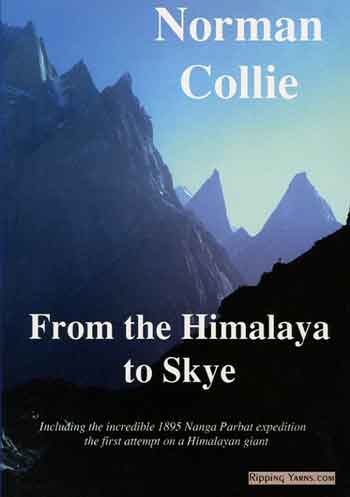


by Norman Collie. First published in 1902. The Ripping Yarns edition was published in 2003. One of Michael Chessler's Top 100 Mountaineering Books. In June 1895, Collie, Albert Mummery, and Geoffrey Hastings left England to make the world's first attempt at an 8000m peak, Nanga Parbat. "We were on the threshold of the unknown." The second half of the book details Collie's climbs in the Canadian Rocky Mountains, The Alps, The Lofoten Islands in Northern Norway, Skye, Ireland, and Scotland. There are 8 pages of b/w/ illustrations reproduced from the 1902 book. Three of those are maps, and three are Nanga Parbat.
They decided the Rupal Face was too difficult, and crossed over the Mazeno la to the Diamer face. "But Eastward, at the head of the valley, towered Nanga Parbat, 14,000 feet above us, one mass of ice and snow, with rock ribs protruding here and there, and vast overhanging glaciers ready at any moment to pour down thousands of tons of ice on to the glaciers below. Lit up a brilliant orange by the setting sun, and with the shadows on the lower snows of a pale green, it certainly looked most beautiful, but up its precipitous face a way had to be found, and at first sight it did not look very promising."
Mummery and Ragobir reached about 20,000 feet on the Diamer Face before turning back because Ragobir turned ill. "I shall always look upon it as one of his finest climbs. ... But is was on too large a scale for ordinary mortals." They decided to go to the Rakiot Face for one last attempt. "There was only one conclusion to draw – Mummery, Ragobir, and Goman Singh had been killed somewhere up the glacier that lies between Ganalo peak and Nanga Parbat. ... From what I have seen of the valley, an avalanche falling from the north face of Nanga Parbat seems the most probably explanation." Collie concludes: "Its rugged insolence, its brutal savagery, and its utter disregard of all the puny efforts of man, crushes out of the mind and idea that this spot belongs to an ordinary world."
Beautifully written, very descriptive, vibrant. You really get the sense of exploration of the unknown.
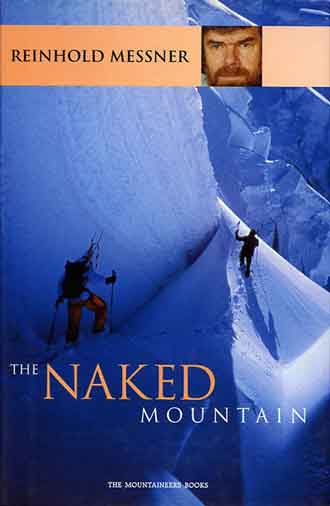
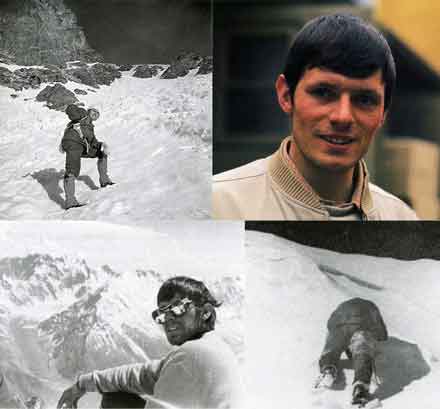
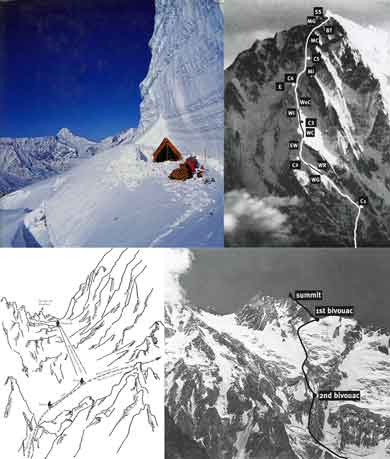

by Reinhold Messner. Published in English in 2003 (German in 2002). Published 32 years after the haunting events of June 1970, Reinhold Messner uses his own and Gunther Messner's letters and diaries, and current thoughts to tell the harrowing and tragic story of the first ascent of Nanga Parbat's Repal Face in June 1970, and the subsequent death of Gunther on the descent down the Diamir Face. "The traverse of Nanga Parbat from south to north-west in 1970 was, for me ... like a border crossing from this world to the next, from life to death, from death to life." There are 13 pages of colour photos, 14 colour photos in-line with text, 10 pages of b/w photos, 90 b/w photos in-line with text, and a 2-page map of Naga Parbat on the inside back cover.
The book begins with the early attempts on Nanga Parbat and Hermann Buhl's solo first ascent of The Naked Mountain in 1953, led by Dr. Karl Herrligkoffer. The story then describes the trip to Base Camp, climbing to set up camps, with the Messner brother leading much of the way. Gunther to his mother: "The Rupal Face, the south face of Nanga Parbat, is bigger and more impressive than I imagined. It is an incredible 4500m of vertical height from Base Camp to the summit and no mountain … can compare with the steepness and the wild aspect."
Reinhold Messner and Gunther Messner broke trail to Camp 5 (7350m), the springboard for the summit push, and then the controversy and tragic events started. Because their high camp was out of radio contact with base camp, Karl had agreed with Messner to set off a blue flare if the weather forecast was good. On June 26 Base Camp set off a red flare by mistake, indicating bad weather. Messner decides: "I would attempt the summit climb tomorrow, alone and moving as fast as possible."
"I was quite alone and climbing on top of the world. ... Suddenly I stopped short. Was that someone following me up? ... It was Gunther. ... Suddenly I found myself standing on a final dome of firn snow – the summit of Nanga Parbat. ... Then he followed me up, step by step, and joined me on the top. He took his mittens off and extended a hand towards me. Two cold hands clasped in a brief embrace." Reinhold and Gunther Messner completed the first ascent of the Rupal Face to the summit of Nanga Parbat on June 27, 1970.
Because Gunther had overexerted himself getting to the summit, Reinhold makes the tragic decision to descend the Rupal Face to the Merkl Gap. The view from the Merkl Gap to the Merkl Couloir "was terrifying", so their only hope was to get the others to fix a rope to them. After suffering through a bivouac at the Merkl Gap, Messner yelled for help to Felix Kuen and Peter Scholz. Felix and Peter thought Reinhold had said he was ok, so they continued climbing towards the summit.
"The choice was simple: attempt to descend or die. ... straight down the Diamir face, a 4000m precipice of rock and ice full of unseen dangers and pitfalls. It was certainly a big risk we were taking. ... It was a life or death decision. We had no rope, no tent and no food." Reinhold Messner led the descent, guiding his debilitated brother all the way. After they had passed the main difficulties, Gunther disappeared. Reinhold deliriously looked for Gunther, "Gunther! I shouted. It was the anguished cry of a lost animal." Reinhold concludes that Gunther must have been buried under an avalanche. Now he has to save himself. "I crawled on like a wounded animal, heading aimlessly down the valley, a man without a purpose, driven only by the will to survive." He finally meets a local peasant and walks slowly and painfully to a village. He eventually gets a jeep, and meets Karl near Gilgit, but neither of them can open up and talk about the events.
Gunther Messner's body was found in June 2005 an hour climb above the Diamir Base Camp, near where Messner had believed Günther might be. Although the August 19 headline in The Times of London claimed "Climber Is Cleared Of Abandoning His Brother", the controversy continues.
Messner's writing is interesting and poetic, letting us know his raw feelings and inner-most thoughts. The tragic events of the descent are chilling and riveting. The photos are very good.
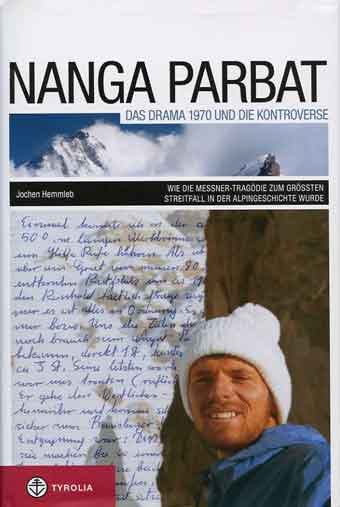
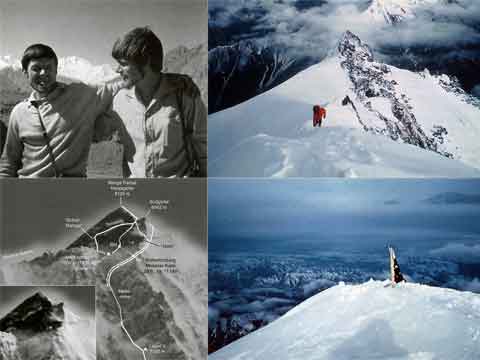
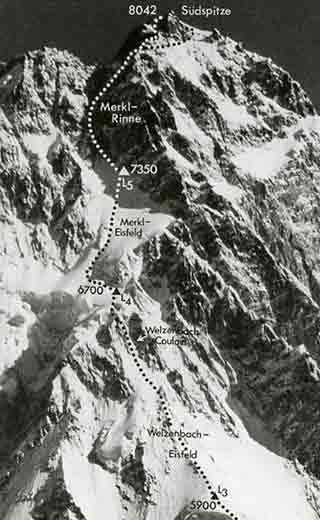
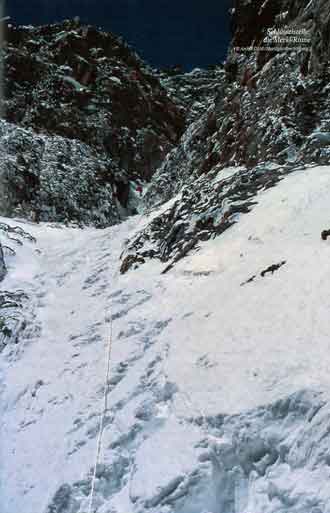
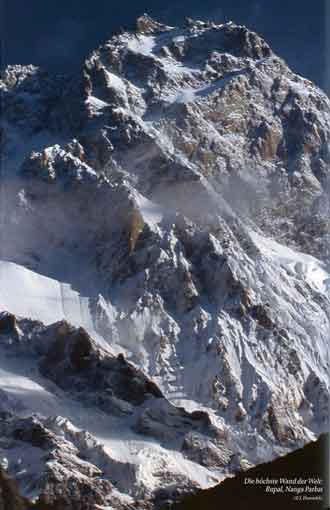

by Jochen Hemmleb. Published 2010 in German. See affimer.org/projects.html There are 17 colour photos and 16 bw photos from 1970; 12 other colour photos and 3 other b/w photos; 3 maps and 11 climbing route diagrams.
Hemmleb uses his detective skills to analyse the controversy surrounding Gunther Messner's death after he and his brother Reinhold Messner completing the first ascent of the Nanga Parbat Rupal Face on June 27, 1970. After the expedition, a bitter controversy arose between Reinhold Messner and Herrligkoffer, in which Messner eventually sued the expedition leader for involuntary manslaughter and negligence. As key points Messner cited the mistakenly fired red rocked, which he regarded as the trigger for the subsequent events leading to Günther's death, and Herrligkoffer's alleged failure to send a search and rescue party to the Diamir side via the Mazeno Pass. Messner lost the court case.
The accusation was brought up again in the context of a new Herrligkoffer biography, edited by Horst Höfler and Messner. This time, the accusation was not levelled at Herrligkoffer, but at the expedition team, together with the statement, "Some of them, older than myself, had nothing against the disappearance of the two Messners, and that is the tragedy." The surviving expedition members, hurt by the renewed accusation, defended themselves by publishing their own accounts of the 1970 expedition, in the form of two books by Max von Kienlin and Hans Saler. They openly questioned Messner's decision to descend the other side of the mountain (which had no camps, fixed ropes, etc.) with an exhausted partner, doubting that it was done out of emergency. Many pointed out discrepancies in Messner's accounts of the events at the summit, at the Merkl Notch, and of the circumstances surrounding Günther's disappearance.
I doubt this controversy will ever be truly resolved, but Hemmleb provides all the details for you to think about. The photos are very good.

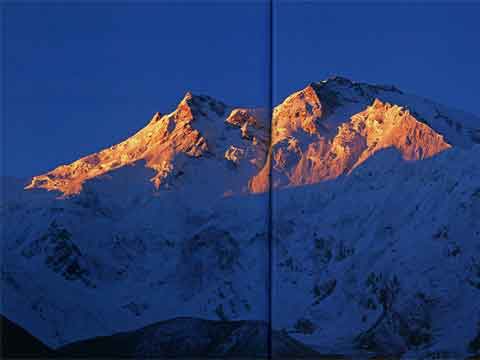
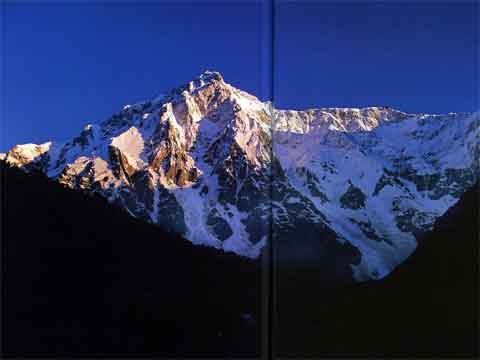
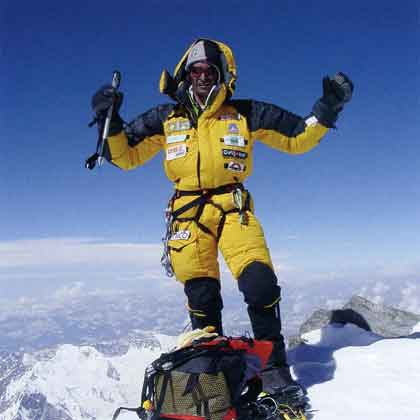

by Alessandro Gogna and Alessandra Raggio. Published in 2008. In Italian. This coffee-table photographic book starts with a brief history of climbing on Nanga Parbat, mainly shows the people and scenery of the surrounding area, and has some photos of the July 20, 2005 climb by the Al Filo de lo Impossibile team, including Silvio Mondinelli from Italy and Ester Sabadell from Spain.
The photos are very good. Because this book doesn't focus on climbing, this book is better for trekking in the area.
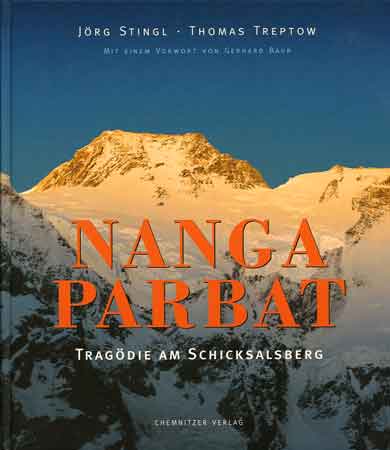
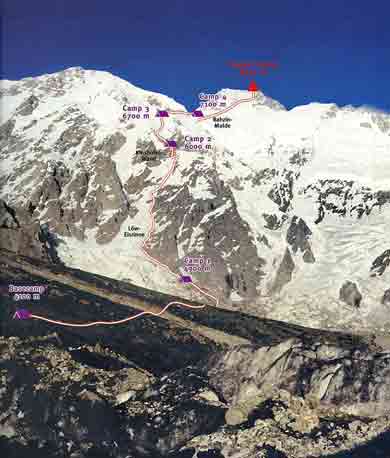
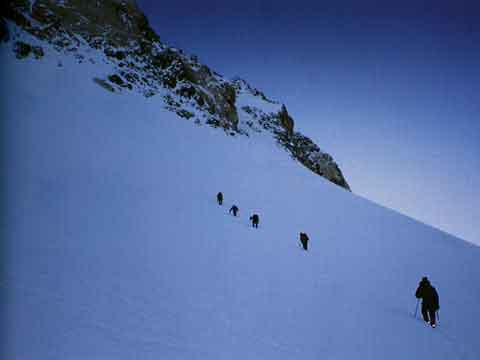

by Jörg Stingl and Thomas Treptow. Published in 2006. In German. The book tells the account in text and many photos of the 2004 German Nanga Parbat expedition. On June 30, 2004 at 21:00 after climbing for 20 hours, Christian and Markus Walter, Günter Jung, Jörg Stingl reached the Nanga Parbat summit. Günter Jung fell on the descent.
The book follows the climbers from Islamabad up the Karakorum Highway, the trek to Diamir Base Camp, life at base camp, and setting up the camps on the Nanga Parbat Kinshofer Route.
The photos are good.
Nanga Parbat has been features in many books over the years. Here are my favourites:
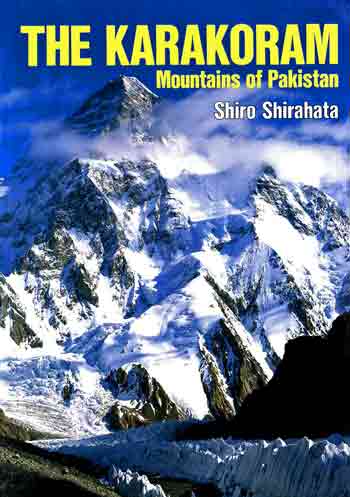
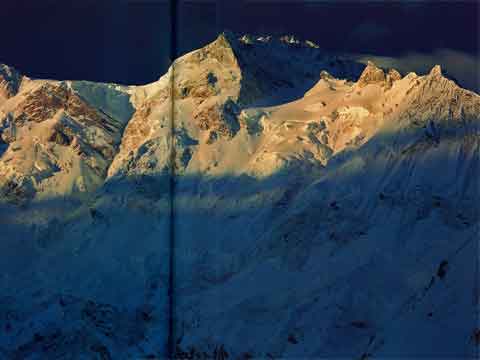
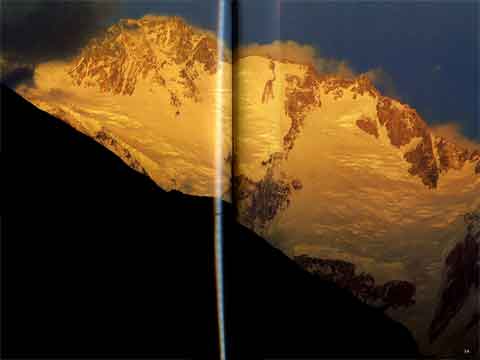
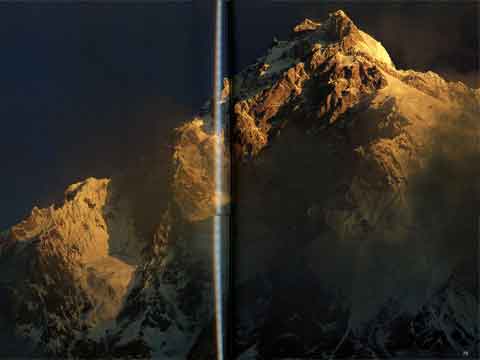

by Shiro Shirahata. First published in 1990. One of Michael Chessler's Best Mountain Photo Books. This coffee-table type book provides stunning large photographs printed on glossy quality paper.
This book contains K2 (cover), Broad Peak, Gasherbrum I, Gasherbum II, Gasherbrum IV, Chogolisa, Nanga Parbat, and Tirich Mir. The photo of Gasherbrum IV on the back cover is stunning.
The photos are excellent. Shirahata just may be the best mountaineering photographer ever.

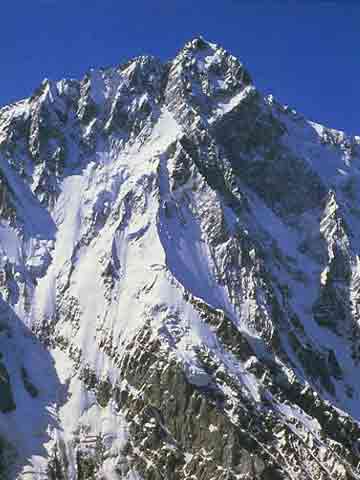

by Richard Sale, John Cleare (Photographer) - Highly recommended! The book details the exploration, first ascent, and other major ascents of all 14 8000m peaks, including spectacular photos.
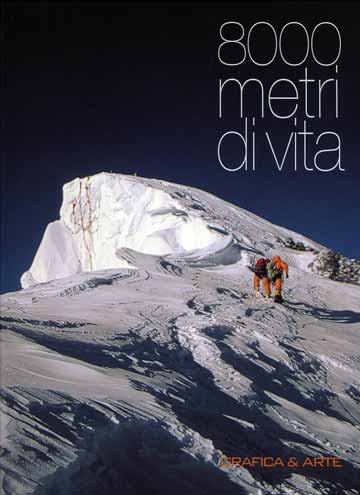

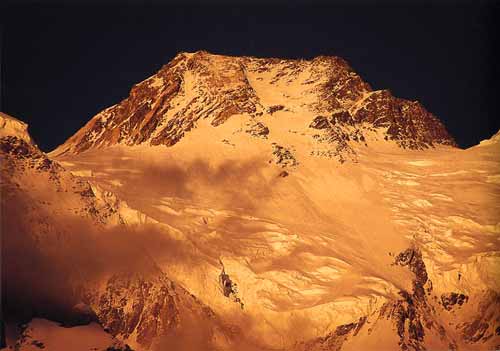

by Simone Moro. Published 2008. In Italian and English. This coffee-table size book features excellent photos from all 14 8000m peaks. Each 8000m peak has a brief history, a photo of each face showing the climbing routes, and lots of excellent photos.
There are 12 pages on Nanga Parbat. Simone Moro and and Jean-Christophe Lafaille opened a new 2100m route to camp 3 (7100m) on the Diamir face of Nanga Parbat in 2003, but Moro failed to reach the summit due to high winds.
The photos and route diagrams are excellent.
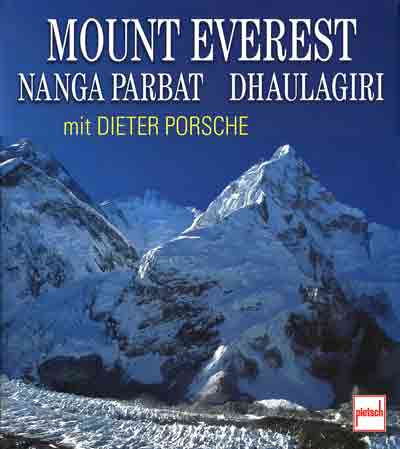
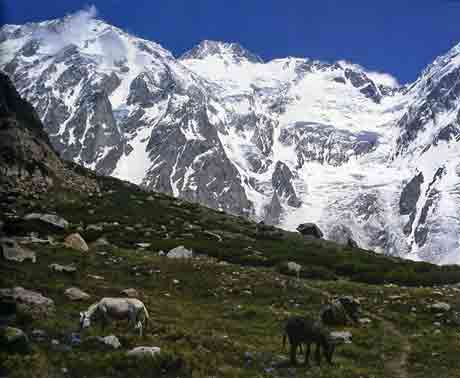
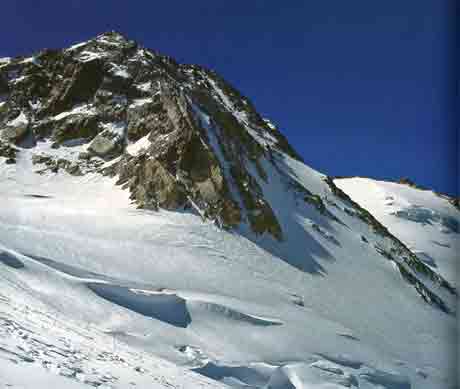

by Dieter Porsche. Published 2009 in German. This is a day by day photographic coffee-table book of Dieter Porsche's ascent of Dhaulagiri in 2003, Nangpa Parbat in1999, and Everest South Summit in 2001. Each chapter begins with a brief history of the first ascent attempts and main ascents and photos illustrating Dieter's ascent route from a distance and close up. You can see Dieter's diary and many photos from the book at alpin-extrem.de.
The Nanga Parbat chapter follows the climbers driving up the Karakorum Highway and trekking to Diamir base camp (4250m), set in a grassy area amongst a profusion of flowers. Alternating ascending and descending to base camp, they set up Camp I (4900m), climb the steep Kinshofer wall to Camp II (6000m), and set up more fixed ropes. After a final rest in base camp, they climb to Camp II and set up Camp III (6800m) and Camp IV (7100m) on the ice-field below the summit headwall. They climb in deep snow and finally up the rocks to the summit. On July 2, 1999 at 16:00 Dieter Porsche, Nick Cofman, and Michel Vincent reached the summit of Nanga Parbat by the standard, Diamir Face Route. The visibility worsened and they quickly left the summit. Dieter lost sight of the others and, with thoughts of his role model Herman Buhl, had to bivouac with expedition leader Peter Guggemos at 7600m. The next day they descend to Camp IV and the following day to base camp.
Even if you can't understand German, the photos are excellent. I especially liked the detailed climbing routes, and that all aspects of the trek and climb are included, not just the highlights.

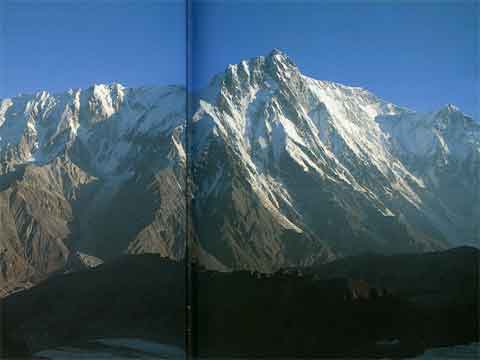
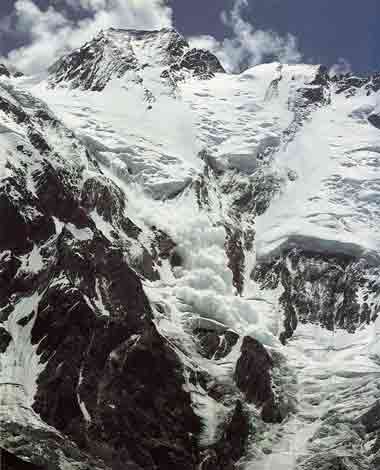
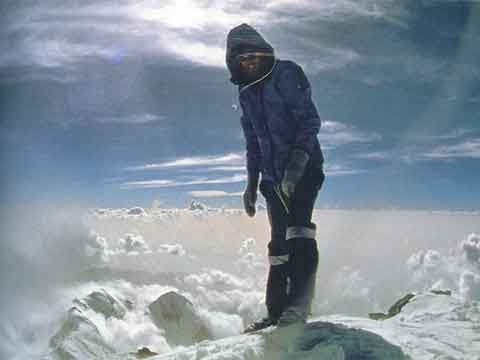

by Reinhold Messner. One of Michael Chessler's Top 100 Mountaineering Books. This book details Messner's ascents of all 14 8000m peaks documented with his photos. He also includes route diagrams and some basic history of the first few ascents. Messner was the first climber to summit all 14 mountains over 8000 metres in height, beginning with Nanga Parbat on June 27, 1970 and finishing with Lhotse on October 16, 1986.
Reinhold Messner and his brother Gunther climbed the incredibly steep 4500m Rupal Face and reached the Nanga Parbat summit on June 27, 1970. They decided to descend the easier Diamir Face, but Gunther disappeared and was probably buried under an avalanche. Messner was back in a tour-de-force in 1978 and climbed the Diamir Face solo, reaching the summit on August 9, 1978.
The photos are very good, the story riveting.

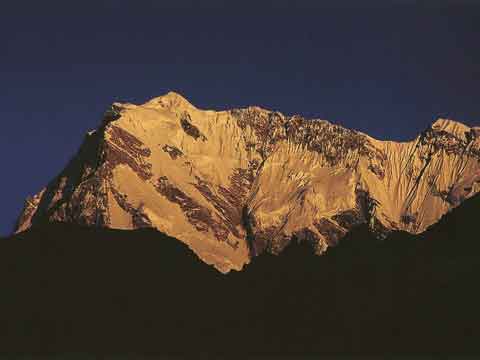
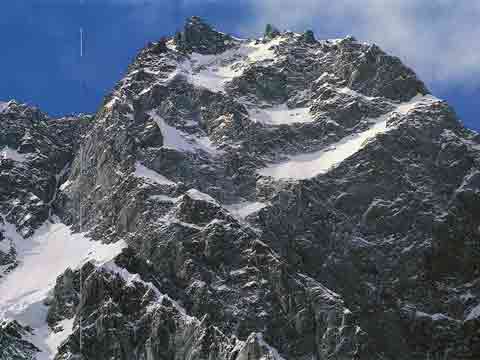

by Marco Bianchi. Published 2003. Although the title claims to be the 14 highest summits in the world, this beautiful, large-format photo book really focuses on the seven mountains the author climbed. The text is in Spanish, but the photos transcend language.
After attempts on Makalu in 1986 and Cho Oyu in 1989, Bianchi summitted seven of the 14 8000m peaks: Manaslu Sept. 28 1992 via Northeast Face, Broad Peak July 6 1993 via Normal route, Cho Oyu Sept. 18 1993 via West Ridge, Shishapangma Oct. 6 1993 via Southwest Face, Dhaulagiri Sept. 25 1994 via Northeast Ridge, Everest May 12 1995 via Northeast Ridge, and K2 Aug. 10 1996 via North Ridge.
There are 6 pages on Nanga Parbat, mainly the Rupal Face.
The photos are excellent.

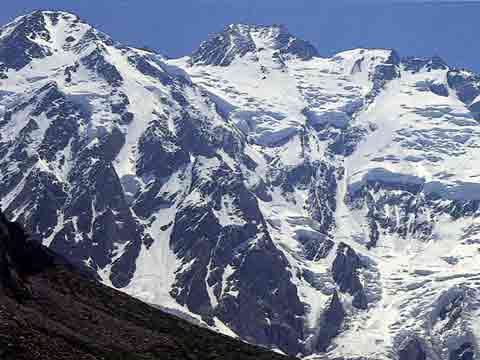
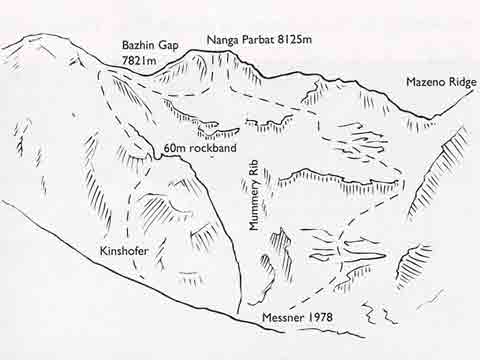

by Andy Fanshawe, Stephen Venables. Published 1996. This book briefly details 40 of the world's finest climbs on mountains in Pakistan (including Broad Peak, K2 and Nanga Parbat), India, Nepal and Tibet (including Annapurna, Shishapangma, Cho Oyu, Everest, Makalu and Kangchenjunga). Each climb is illustrated with many great photos, climbing routes, and summary statistics and information. Each area has an excellent overview map.
There are four pages on Nanga Parbat Diamir Face Kinshofer Route.

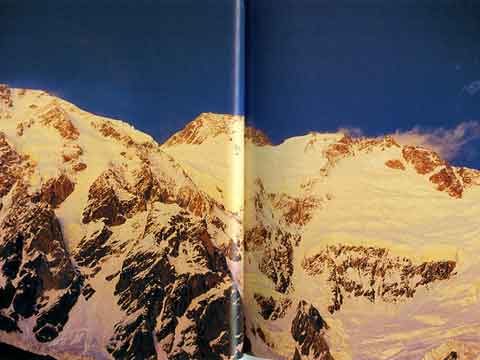
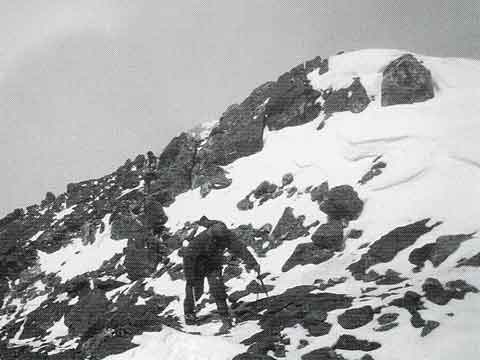

by Kiko Betelu. Text in Spanish. Spaniard Juanito Olarzabal became the sixth mountaineer to summit all 14 8000m peaks when he reached the summit of Annapurna on April 29, 1999. This book reviews each of his 14 ascents with text, photos, and route maps. There are 65 colour photos and 42 b/w photos. With his ascent of Makalu in May 2008, Juanito holds the record for the most ascents of 8000m peaks with 22.
Oiarzabal's ascent of Manaslu via the Northeast Face on October 8, 1997 is detailed in a 7-page chapter with 6 colour photos and 1 b/w photo.
The photos are very good, especially on the summit.
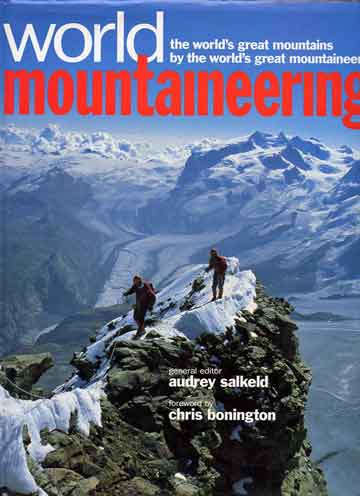
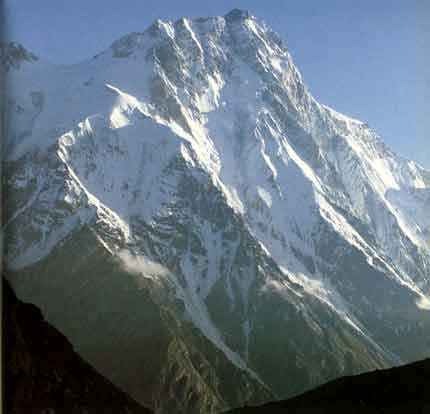
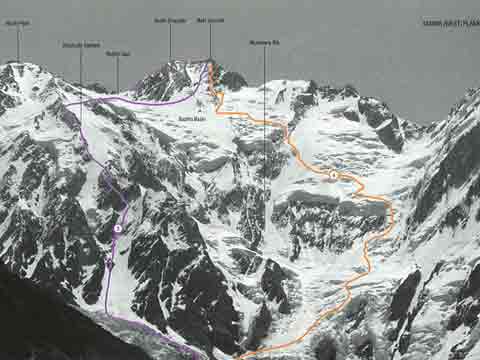

by Audrey Salkeld. Published 1998. The book briefly details 52 of the world's finest climbs from Europe (including Mont Blanc, the Matterhorn and the Eiger), Arctic and North America, South America, Antarctica, Indonesia and Oceania, High Asia and Korea and Japan (including K2, Nanga Parbat, Kangchenjunga, Mount Everest), and Africa. Each climb is documented with photos, excellent aerial-type maps, and a basic climbing history.
There are 4 pages on the Nanga Parbat, and a 2-page article by Anderl Heckmair on the first ascent of the North Face.
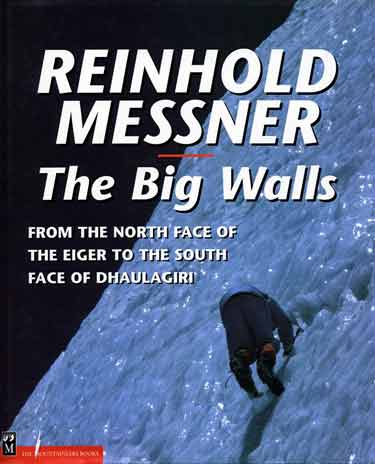
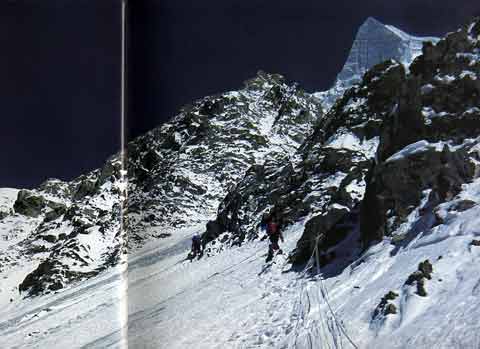
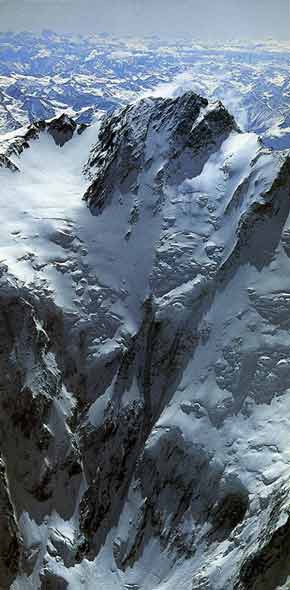
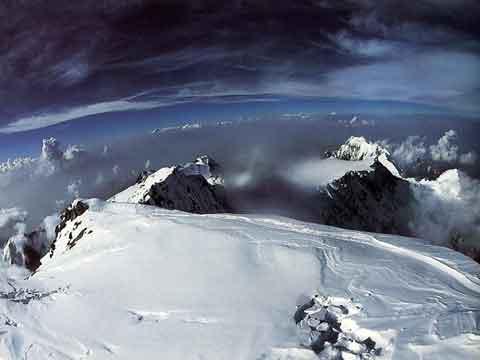

by Reinhold Messner. Revised in 2001. Messner briefly details the big mountain walls in the world in the Himalayas, the Karakorum, the Alps, South America, Alaska and the Caucasus.
It includes 10 pages on the Nanga Parbat Rupal and Diamir Faces, and 3 additional photos.
I like this as a reference book. The photos are very good.
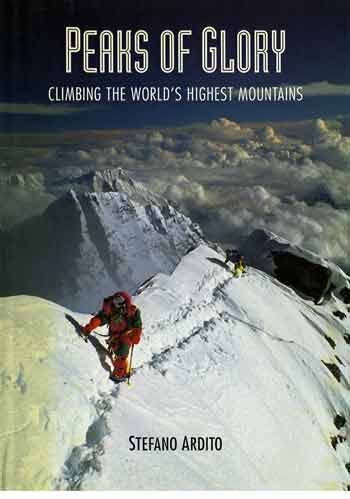
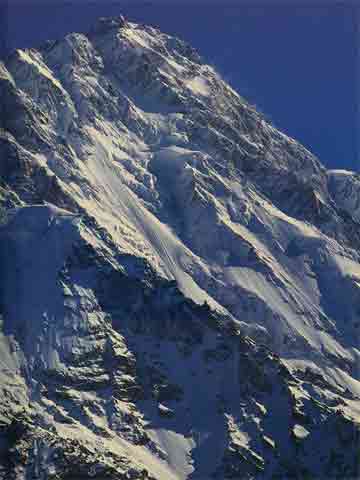
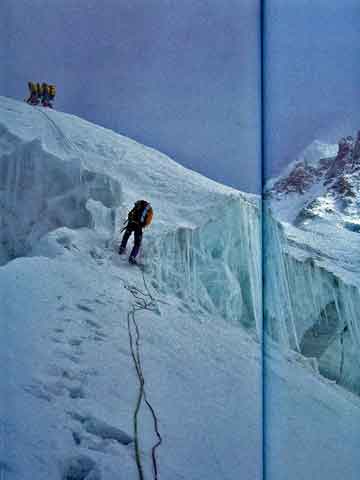

by Stefano Ardito. Publishd 1993. This is a large coffee-table style book with excellent photos, briefly listing the most challenging mountains on each continent, including Everest, Annapurna, Nanga Parbat, K2 and the Trango Towers in the Himalaya, and K2, Denali and Aconcagua, and Mont Blanc and the Matterhorn.
There are 8 pages on Nanga Parbat.
The photos are very good.
In addition to youtube.com videos, I found these DVDs:
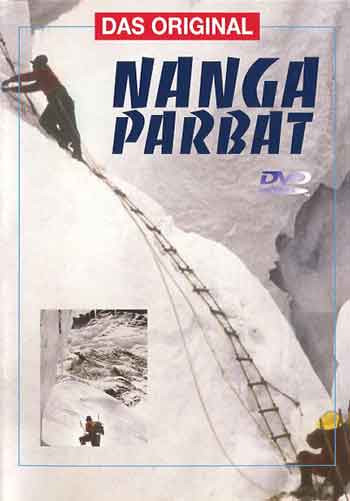
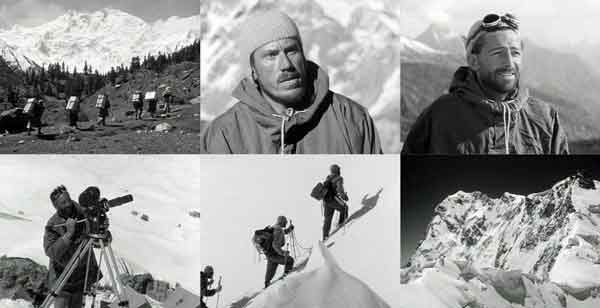
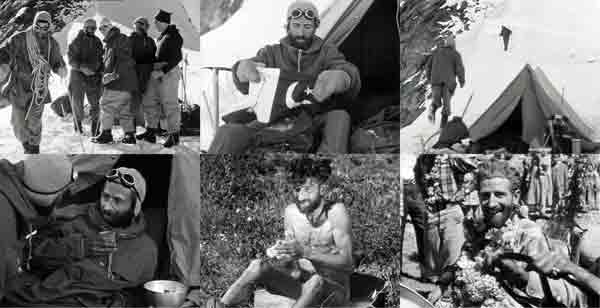

By Hans Ertl from the German-Austrian Himalaya-Expedition 1953. In German. Black and white. 90 minutes. Filmed in 1953. Released 1953.
The film opens with scenes of newspaper articles for the expedition, swimming on board the ship to Karachi, scenes from the train journey to Rawalpindi and the flight to Gilgit passing Nanga Parbat, and the reception in Gilgit. The expedition baggage is carried on donkeys and then by porters as the team treks to Fairy Meadows and on to base camp.
After base camp is set up, it's more carrying on the snow and glaciers and icefalls and avalanches to Camps 1 (4466m), 2 (5350m) 3 (6185m), and 4 (6690m), slowly breaking trail in the deep snow. At Camp 2 they look at the maps and plan their route, and playfully share a Lowenbrau beer. There are a few base camp scenes with Karl Herrligkoffer administering medicine, listening to the radio for weather reports, and scenes of communication between the higher camps and base camp.
On July 2, Buhl, Otto Kempter, Walter Frauenbergar and Ertl climb to Camp 5 (6900m) with great views of the Silbersattel (7500m) and the Nanga Parbat summit ridge. Ertl and Fruenberger wish Buhl and Kempter well and return to Camp 4. Hermann and Otto get their rucksacks ready for the 1225m vertical ascent over a horizontal distance of 1400m, with Buhl holding up the Pakistani flag he will bring to the summit.
Ertl illustrates Buhl's solo climb to the summit of Nanga Parbat on July 3, 1953 at 19:00, using shots of the shadow of a solitary climber, long shots of a solitary climber on a long ridge unfurling the Pakistan flag and then starting down. The sun goes down with stars in the sky before a new day dawns and the shadows of the solitary climber slowly comes back to be met by Ertl and Frauenbergar at Camp 5. He gives Buhl a brew and takes his boots and socks off, displaying his frostbitten toes. We see Ertl and Frauenberger erect the memorial plaque to Willy Merkl, and then everybody comes down through the icefall, across ladders over deep crevasses, and to the grass of base camp. We see an almost nude and emaciated Buhl soaping up and cleaning himself. The team drives back and Buhl is congratulated by the Pakistanis, followed by scenes of polo, with Buhl smiling and clapping.
For a film more than 50 years old, the quality of the print is excellent - very clear. There really isn't much narration, so you don't need to understand German. It was wonderful to see the youthful Hermann Buhl age before our eyes as the climb goes on. The chaotic icefall and avalanche scenes are spectacular, clearly showing the danger and the slow breaking of the trail. The pace is nice and slow, not too huried.
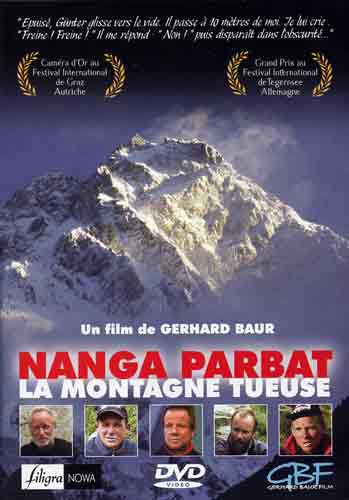



By Gerhard Bauer. In German with Fench subtitles. 44 minutes. Filmed in 2004. Released 2005. The video starts innocently enough with scenes of Nanga Parbat base camp, the Diamir face, and interviews with the climbers. There is a brief review of the first ascent of the Kinshofer Route in 1962 with interviews with Manfred Sturm and Anderl Mannhardt. On June 26, 2004 the climbers leave base camp for their sunmmit attempt. Günter Jung, Jörg Stingl, Jens Triebel, Christian and Markus Walter set out for the summit from Camp IV (7200m) in the early morning hours of June 30. If Günter succeeded, he would become the oldest Nanga Parbat summiter at the age of 64. The snow was deep, their progress slow. Günter was going exceptionally strong, time and again forging ahead and breaking trail. As evening approaches, Jens decides to descend while the others keep going up. Finally, at 9:15 p.m.Jorg, Günter, Christian and Markus reach the summit. Christian and Gunter quickly start the descent while Jorg and Markus take their time on the summit.
At 11.15 p.m. Markus catches up with Günter in the summit couloir. Günter is pretty much exhausted and freezing. Jorg catches them and the three descend together. Around 12.45 p.m. Günter loses his footing! Jörg rushes towards him, tries to stop him, but is knocked off his feet, sliding down with him. After 10 meters Jörg catches himself, but not Günter, who slides into the void at a steady speed. Markus hears the noise, turns around, but is too far away to do anything. From 10 meters away Markus has to watch helplessly as Günter slides past him, vanishing in the void and darkness. A steady sliding noise - after that, silence...
After dawn arrived, Markus wondered if it was possible that Gunter was still alive, and so, rather than go to Camp IV, he headed down the steep slopes to search for Gunter. The terrain gets increasingly steeper, but Markus keeps descending, stumbling, sliding, rolling, catching himself - only to climb on downwards and fall again. Finally his last fall stops almost 600m near the top of the Mummery Rib. After lying motionless in the snow for hours in the snow, he finally wakes up around 5 p.m. and realizes the condition he is in - over 300m below the Bazhin Basin without his hat, gloves, ice axe, ski pole, radio, and his thick down jacket, which fell off in his fall. With only one crampon, he ties one of his two shirts around his head and breaks a new trail upward. At sunset as the cold creeps through his body, he pulls the shirt off his head and puts it on. Around 1 a.m. Christian climbed out of his tent and on to a nearby scarp to look down the wall. Already Markus' shouts sounded much nearer. Shortly before 2 a.m. Markus staggers into his brother's arms - almost 50 hours after they had set out for the summit together. Markus was suffering from bruises, hematoma, and abrasions, as well as frostbite to his ears and a broken vertebra. Thew video ends with their safe descent back to base camp.
Baur intersperses interviews with the four climbers, Michi Schafroth at base camp and reenactments of the events high on the mountain to tell a riveting story packed with emotion and suspense. The filming and pacing are both excellent. The use of video scenes taken from the climber's perspective delivers the frightening experience in vivid detail.
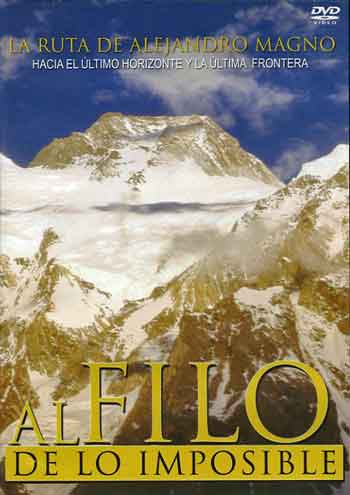
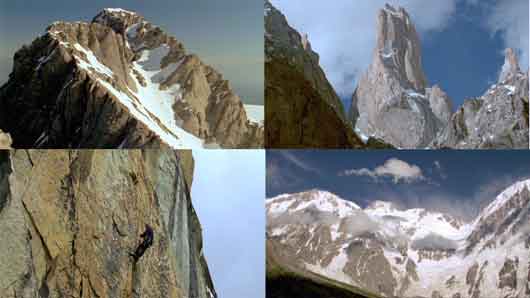
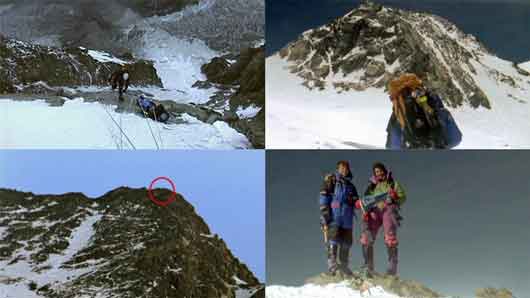

by Sebastian Alvaro. Al Filo De Lo Imposible, Spanish TV. 107 minutes. Filmed in 1999. Released 2002. Spanish mountaineers Jose Carlos Tamayo, Felix and Alberto Iñurrategi, and Jon Lazcano follow the Route of Alexander The Great, climbing Mount Olympus (2919m) in Greece, briefly visiting Athens, Persepolis and Tehran, climbing Alam Kooh (4850m) and Damavand (5671m) in Iran, and climbing Trango Tower (6230m) and Nanga Parbat (8125m) in Pakistan.
After Greece and Iran their bus trip continues to Pakistan with a few city scenes and a visit to Hindu Kush and scenes of the villages, children, and women in beautiful traditional dress. The four mountaineers then travel to the Baltoro area where they climb Trango Nameless Tower (6230m), using lots of artificial aids. There is a spectacular view of the Karakoram from the summit.
The second half of the film begins with the bus trip and trek to the Diamir Base Camp to climb Nanga Parbat using the Kinshofer Route. As soon as they set up base camp, they are asked to help an injured climber at Camp 2. They climb the glacier, snow covered rocks, and rocks to Camp 2, with one of the high altitude porters carrying a stretcher. They strap the badly injured Columbian climber, Volker Stalbhom, to the stretcher and slowly lower him down the Diamir Face and a helicopter flies him out.
The climbers start again for the mountain and climb up ice and steep rocks to Camp 2 where they cook and eat pasta. The ever present danger of avalanches is illustrated with footage of enormous avalanches going down the face. They leave early in the morning and continue the climb up the ice and snow, getting slower and resting often as they gain altitude. Long telephoto shots are used to tell us where the climbers are and the enormity of their undertaking. Looking quite knackered, they squeeze into a small bivouac tent and eat and rest. They then continue up rocks with Jose Carlos Tamayo, and Felix and Alberto Iñurrategi reaching the summit in clear perfect weather on July 29, 1999. The camera circles around the summit, looking down on the Buhl route, as they enjoy the view and take photos.
There is also a short interview with Reinhold Messner who talks about his 1970 descent down the Diamir Face and his brother Gunther's death, and some footage from 1930s German climbs and Hans Ertl's 1953 film of the first ascent.
The filming of the Diamir face is excellent, clearly showing the climbing route and the summit area. The sunset scenes are especially beautiful. They use close up, broad view, and extreme telephoto to give the depth and scale and steepness of the climb. The rescue clearly illustrates the danger of mountain climbing and the difficulty of being rescued.
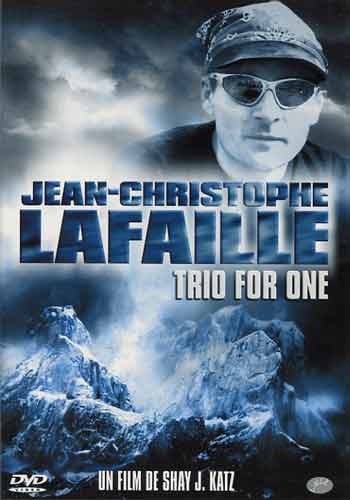
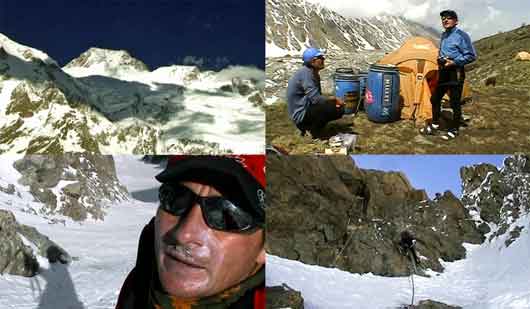
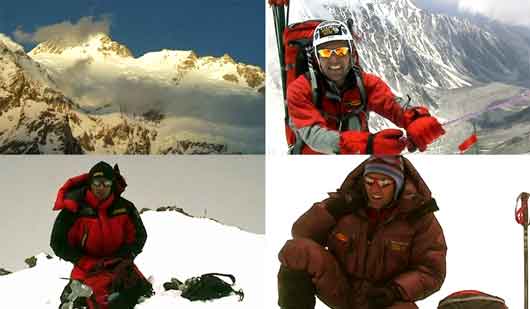

This 56-minute film follows famed French mountaineer Jean-Christophe Lafaille's exploits in 2003, climbing Dhaulagiri solo (May 20), and Nanga Parbat (June 24) and Broad Peak (July 15) with Ed Viesters. The narration is in French with English subtitles. One of the bonus features is a video of his ascent of the Shishapangma (Dec 11, 2004) solo in winter. Another bonus is a 12-minute interview with JC and Ed Viesters. Lafaille disappeared on January 26, 2006 near the summit of Makalu, attempting the first solo winter ascent.
The 18-minute chapter on Nanga Parbat begins with the drive up the Karakorum Highway and the trek to Nanga Parbat Base Camp, quite pleasantly set in a grassy area amid flowers. JC and Ed Viesturs acclimatize by climbing to camps 1 and 2, but then JC falls ill with food poisoning and and has to return to Base Camp to recover. After recovering, JC climbs a new 2000m route on the Diamir Face with Simone Moro before joining Ed on the normal Linshofer route. Simone is still not acclimatized and turns back. Ed and JC leave camp 4 on June 24 at 4am, and after an 8-hour climb reach the summit of Nanga Parbat.
Filmed by Lafaille himself much of the time and Ed Viesturs, I liked the honest portrayal of a mountaineer dealing with the struggles of climbing, his illness, and the basics of life like eating and melting snow for drinking. The mountain views are very good, but there is no film from camp 4 to the summit. There is film of JC and Ed on the the summit, but it is cloudy.
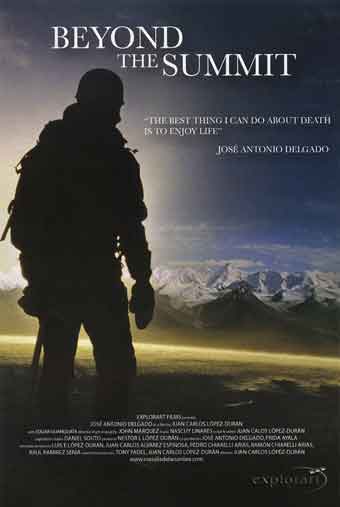
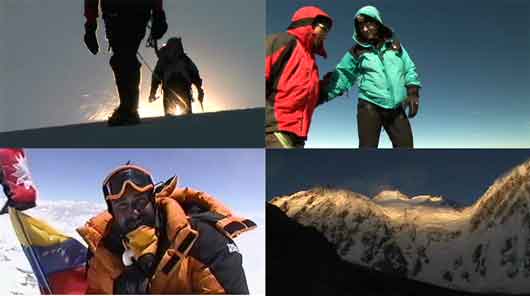
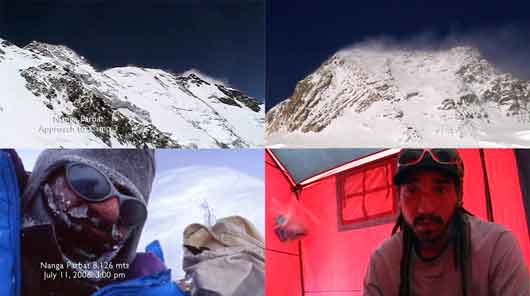

Directed by Juan Carlos López-Durán. Starring José Antonio Delgado. Released 2008. 78 minutes. In Spanish with English subtitles. This film is an intimate look at the philosophy and life of Venezualan mountaineer Jose Antonio Delgado. "To win the race against death, you must really do the things you are really want to do, what you're passionate about." "... I feel the mountain is doing me a favour by allowing me to be there, appreciating so much beauty, bringing me so much satisfaction, and allowing me to test myself physically and mentally." "You reach the summit, a second of Euphoria, and then come back to reality. Because you know your are only half way there. ... For me, the real summit, the real finish, the real moment of celebration is when I get home."
In addition to the interviews with Jose and his wife, we see brief climbing sequences on Khan Tengri Expedition (7010m) in August 2005, Gasherbrum II in July 2000, and with Marcus Tobia becoming the first Venezualans to reach the Mount Everest summit on May 23, 2001. We also see a beautifully filmed ascent with Edgar Guariguata to Green Lake, across the Humboldt Glacier and on to the summit of Humboldt Peak (4942m) in Venezuala in December 2005. The crux of the climbing is on Nanga Parbat, where after summiting on July 11, 2006, Delgado died after 10 days fighting fiercly against an unforgiving storm without food or weater, trapped at Camp 4. Strung throughout the film is a wonderful cartoon story "The Great Mountain" written by Jose and narrated by Jose's children Sofia and Tomas of a camel, yak, kangaroo and an elephant who climb a great mountain.
"The mountain seems difficult, super difficult, and we are shaken by the thought that we will climb it. ... I ask her to be compassionate, to not send me a big storm" Delgado and his partner Edgar Guariguata trek to Nanga Parbat Base Camp and climb to camp 2. Edgar is not feeling well and goes back to Base Camp. Jose continues alone to Camp 3 where he stays the night, eating only chocolate mouse. Although he professes to be a conservative climber, when a forecasted weather window opens, Jose decides to go alone. Although a storm does hit, Jose Antonio Delgado continues and reaches the summit of Nanga Parbat on July 11, 2006 at 15:00. He can't find Camp 4 on the descent and has to bivouac at 7800-7900m before finding Camp 4 the next day.
We watch what is happening on the mountain thru the radio contact between Edgar at Base Camp and Jose. Jose tells Edgar that his feet are frozen, and Edgar implors Jose to "crawl! Crawl to Camp 3." Edgar is helpless and cannot help Jose, "He's f**ked alone, but ... I can't do anything .. This isn't living. ... I'm dying with him." On July 22, 2006 a group of six Pakistani mountaineers found Delgado's body at an altitude of 7100m between camp three and four in the open near his tent.
This is the best film I have ever seen that clearly describes why people become mountaineers - the absolute love and joy of climbing. The cartoon story is delightful, and the climbing sequences, especially Humboldt Peak, are excellent.
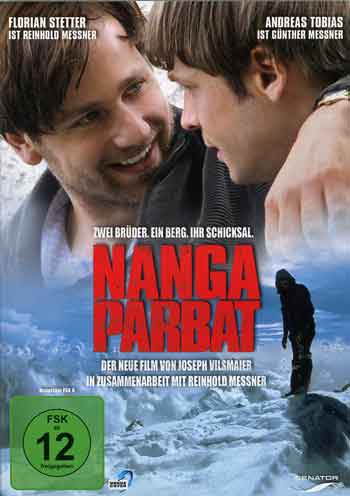
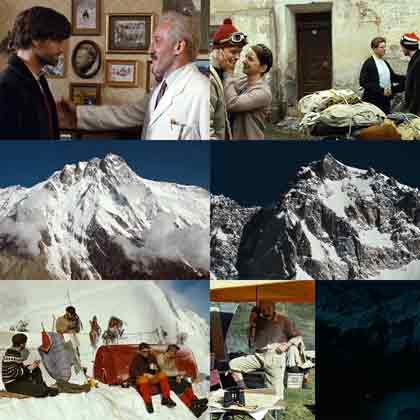
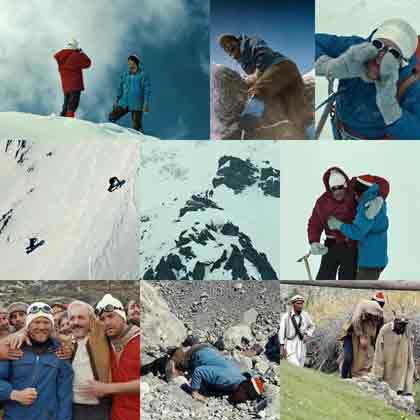

Directed by Joseph Vilsmaier. Filmed on location in Pakistan, South Tyrol and the Austrian Alps. Starring Florian Stetter as Reinhold Messner, Andreas Tobias as Gunther Messner, and Karl Markovics as Karl Maria Herrligkoffer. Released 2009. 99 minutes. In German. This film tells the controversial story from Reinhold Messner's perspective of Reinhold and Gunther Messner's ascent of the enormous 4500m Rupal Face of Nanga Parbat in 1970, and Gunther's death on the descent down the Diamir Face. It was the first traverse of Nanga Parbat.
The film opens with scenes of Reinhold Messner and Gunther Messner growing up, their family, and a few climbing scenes. Reinhold goes to visit Karl Herrligkoffer in May 1969 to try and get on his planned expedition, and then Gunther Messner gets invited when another climber drops out. A recurring scene in the movie is Reinhold arriving on crutches and interrupting a lecture by Herrligkoffer in Munich after the end of the expedition, to tell the audience his view of the expedition and the struggle of he and his brother. At a formal dinner in Islamabad, Reinhold spars with Karl - Reinhold comes across cocky, irreverent, outspoken, and we can see this aggravates Karl and some of his fellow climbers. Karl comes across indecisive, nervous, and jumpy, deferring to Reinhold much of the time. There are some very good scenes of the chaotic Pakistani street, village and people, and the trek to base camp.
Reinhold and Gunther Messner lead the climbing and setting up camps, while Karl Herrligkoffer dictates the expedition report in the comfort of base camp. Reinhold and Gunther Messner, Felix Kuen, Peter Stolz and Gerhard Baur eventually are in place for a summit attempt. Reinhold calls Karl on the phone and they agree that if there is bad weather forecast, base camp will set off a red flare and Reinhold will then try for the summit alone. Although the weather forecast was good, base camp set off the red flare. On June 27 at 3:00, Reinhold set off by himself to try and reach the summit. Gunther gets up a a few hours later and decides to follow Reinhold. He catches up with Reinhold, who gives in that his brother can join him. Together, they reach the summit of Nanga Parbat on June 27 at 17:00.
Gunther was starting to suffer from altitude sickness and told Reinhold he was too weak to descend by the same difficult ascent route. Reinhold and Gunther descend on the Diamir side and bivouac next to the Merkl Gap at 7800m in cold -40C weather with only thin foil space blankets for shelter. Their toes froze solid. The next morning Reinhold sees Felix Kuen and Peter Scholz just 100m away climibng towards the summit. Reinhold yells to Felix to get him to climb up and give him a rope so they could rapel down and regain the ascent route. Felix doesn't understand, and to Reinhold's horror continues climibing towards the summit. Maybe the wind confused their exchange of words.
Reinhold returned to the bivouac site to tell Gunther they had been abandoned, and now had no choice but to descend the Diamir, making a full traverse of the mountain. Gunther was having trouble walking, but Reinhold led the way, working out a descent route from his memory of pictures of the face. That night the brothers survived another bivouac. By midday on June 29, they were low on the Diamir Face, but Gunther trailed farther and farther behind. The brothers had almost nothing to eat or drink for 40 hours. Reinhold hurried ahead, passing out of sight of his brother, and found ice water to drink. Meanwhile, Felix and Peter made it to the summit and returned to base camp, welcomed by Karl as heroes.
After waiting for Gunther, Reinhold, though utterly spent, climbed back onto the glacier, finding a fresh pile of snow and huge, jumbled blocks of ice from a recent avalanche. Reinhold eventually had to give up and save himself, crawling part of the way because of his frozen feet. A series of sturdy villagers carried him on their backs down to the lowlands. He returns home with frostbite so severe that six of his toes had to be amputated.
I like this movie for the dramatization of Reinhold Messner's tragic story of the first ascent the enormous Nanga Parbat Rupal Face. Yes, it is Messner's views, not the other people's views, but I frankly believe Messner. The climbing scenes are well done, giving you some of the feeling of the climb, the height and steepness. I really liked the integration of actual footage of Nanga Parbat with the scenes filmed in Europe. The movie doesn't really portray the depth of the emotions in the film very well. Except for Karl Markovics, whose acting as Karl Maria Herrligkoffer was convincing and interesting, the acting was a a little one-dimensional and superficial.
Extras include Interviews (20 minutes) with the actors and Reinhold Messner, and The Making Of (50 minutes), where we see how heavily Reinhold Messner was involved in the production.